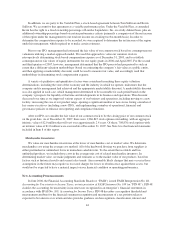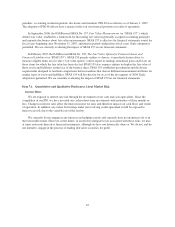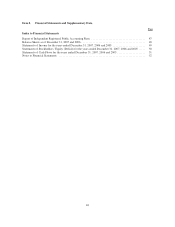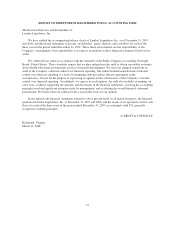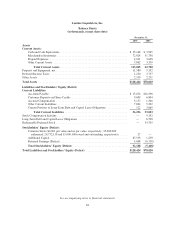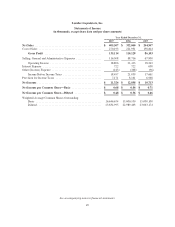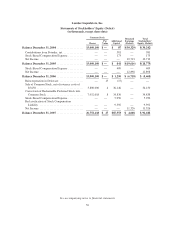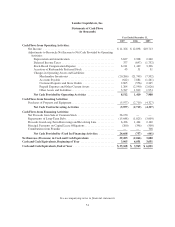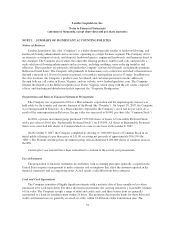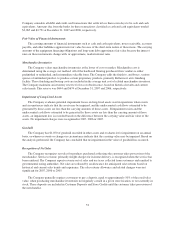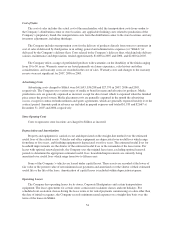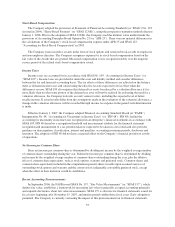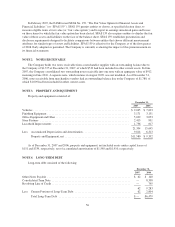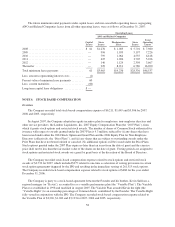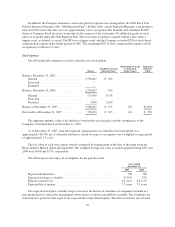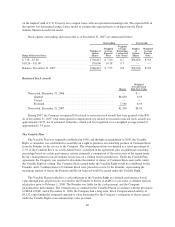Lumber Liquidators 2007 Annual Report Download - page 59
Download and view the complete annual report
Please find page 59 of the 2007 Lumber Liquidators annual report below. You can navigate through the pages in the report by either clicking on the pages listed below, or by using the keyword search tool below to find specific information within the annual report.Company considers all debit and credit card transactions that settle in less than seven days to be cash and cash
equivalents. Amounts due from the banks for these transactions classified as cash and cash equivalents totaled
$2,065 and $2,791 at December 31, 2007 and 2006, respectively.
Fair Value of Financial Instruments
The carrying amounts of financial instruments such as cash and cash equivalents, notes receivable, accounts
payable, and other liabilities approximate fair value because of the short-term nature of these items. The carrying
amounts of the equipment financing obligations and long-term debt approximate fair value because the interest
rates on these instruments change with, or approximate, market interest rates.
Merchandise Inventories
The Company values merchandise inventories at the lower of cost or market. Merchandise cost is
determined using the average cost method. All of the hardwood flooring purchased from vendors is either
prefinished or unfinished, and in immediate saleable form. The Company adds the finish to, and boxes, various
species of unfinished product, to produce certain proprietary products, primarily Bellawood, at its finishing
facility. These finishing and boxing costs are included in the average unit cost of related merchandise inventory.
The Company maintains an inventory reserve for loss or obsolescence, based on historical results and current
sales trends. This reserve was $644 and $674 at December 31, 2007 and 2006, respectively.
Impairment of Long-Lived Assets
The Company evaluates potential impairment losses on long-lived assets used in operations when events
and circumstances indicate that the assets may be impaired, and the undiscounted cash flows estimated to be
generated by those assets are less than the carrying amounts of those assets. If impairment exists and the
undiscounted cash flows estimated to be generated by those assets are less than the carrying amount of those
assets, an impairment loss is recorded based on the difference between the carrying value and fair value of the
assets. No impairment charges were recognized in 2007, 2006 or 2005.
Goodwill
The Company has $1,050 of goodwill recorded in other assets and evaluates it for impairment on an annual
basis, or whenever events or changes in circumstance indicate that the carrying value may be impaired. Based on
the analysis performed, the Company has concluded that no impairment in the value of goodwill has occurred.
Recognition of Net Sales
The Company recognizes net sales for products purchased at the time the customer takes possession of the
merchandise. Service revenue, primarily freight charges for in-home delivery, is recognized when the service has
been rendered. The Company reports revenue net of sales and use taxes collected from customers and remitted to
governmental taxing authorities. Net sales are reduced by an allowance for anticipated sales returns based on
historical and current sales trends and experience. The sales returns allowance and related changes were not
significant for 2007, 2006 or 2005.
The Company generally requires customers to pay a deposit, equal to approximately 50% of the retail sales
value, when purchasing merchandise inventories not regularly carried in a given store location, or not currently in
stock. These deposits are included in Customer Deposits and Store Credits until the customer takes possession of
the merchandise.
53



